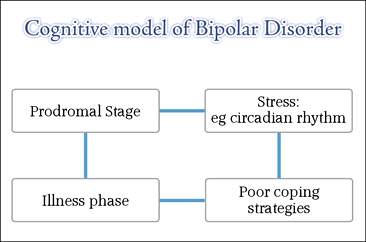
Tel: 0800 078 7712
Home | Common Problems | Therapies | Therapy Format | Common Myths | Consultancy | Contact | Links
Expert; Individual; Formulation driven CBT
Copyright © 2022, A.S.T. Consultancy.
Bi-polar disorder
Bi-
Approximately one percent of the population develop bipolar disorder and currently there is no clear idea as to what causes it. The disorder does not seem biased towards either gender, striking indiscriminately. The age of onset appears to be late teens to late twenties; approximately half of the diagnosed cases occur before the age of twenty five.
There are several classifications of this disorder, these being:
- Bi-
polar (i) disorder : defined by manic or mixed episodes that last at least seven days, or by manic symptoms that are so severe that the person needs immediate hospital care. Usually, the person also has depressive episodes, typically lasting at least two weeks. The symptoms of mania or depression must be a major change from the person's normal behaviour. - Bi-
polar (ii) disorder : defined by a pattern of depressive episodes shifting back and forth with hypo-manic episodes, but no full- blown manic or mixed episodes. - Bi-
polar disorder (NoS) : diagnosed when a person has symptoms of the illness that do not meet diagnostic criteria for either bipolar (i) or (ii) but the symptoms are clearly out of the person's normal range of behaviour. - Cyclothymia: is a mild form of bipolar disorder. People who have cyclothymia have
episodes of hypo-
mania that shift back and forth with mild depression for at least two years. However, the symptoms do not meet the diagnostic requirements for any other type of bipolar disorder.
Rapid-
Elated or manic phase
- A long period of feeling ecstatic, high, or an overly happy or outgoing mood
- Extremely irritable mood, agitation, feeling restless, jumpy on edge or tense
- Behavioural changes
- Talking very fast, jumping from one idea to another, having racing thoughts
- Being easily distracted
- Increasing goal-
directed activities, beginning new projects or assuming more responsibilities - Being restless
- Sleeping little
- Having an unrealistic belief in one's abilities
- Behaving impulsively and taking part in a lot of pleasurable, high-
risk behaviours, such as spending sprees, impulsive sex, and impulsive business investments
Depressed phase
- Mood changes
- A long period of feeling low, worried or empty
- Loss of interest in activities once enjoyed, including sex
- Behavioural changes
- Feeling tired or bogged down
- Having problems concentrating, remembering, and making decisions
- Being restless or irritable
- Changing eating, sleeping, or other habits
- Thinking of death, making plans for, or attempting suicide
Formulation
The Cognitive Behavioural Psychotherapist will collaborate with the patient and assess all maintaining factors; including thoughts, behaviours, emotions and physical symptoms associated with the problem and develop a working formulation which will be utilised to provide a framework to understand bipolar disorder and to guide the course of therapy.
Treatment
A number of techniques will be employed to test predictions and beliefs which will include
behavioural strategies to demonstrate the link between behavioural changes and relapse and cognitive interventions aimed at identifying and challenging unhelpful thoughts and beliefs, possible thinking errors and misinterpretations. These may then be challenged through a combination of verbal reattribution, Socratic questioning and behavioural experiments.
Final stages of the therapeutic interventions explore relapse prevention strategies.
It must be understood that this disorder has lifetime prevalence, so that CBT (or any other intervention for that matter) will not cure the disorder for once and for all but can greatly aid the sufferer to manage and reduce the impact of this disorder.

